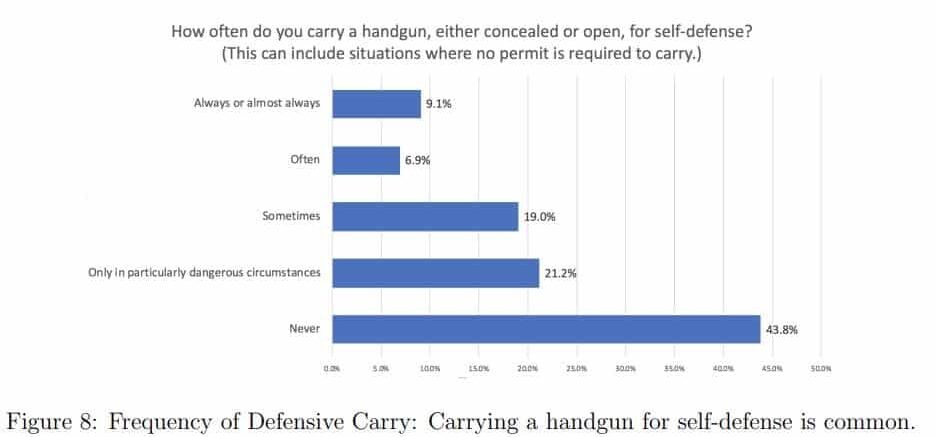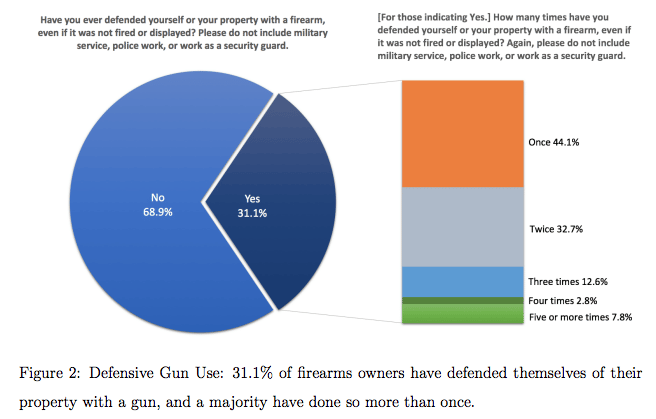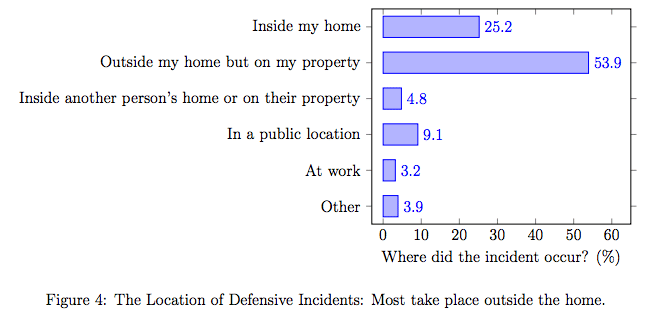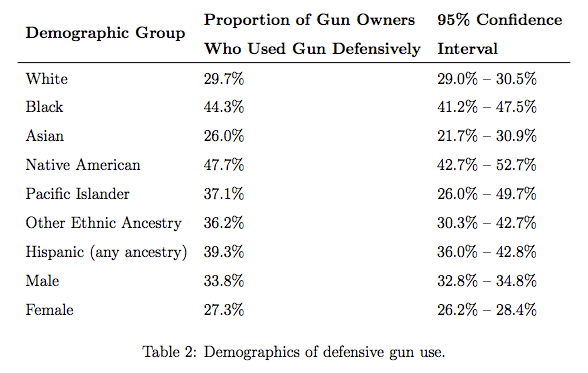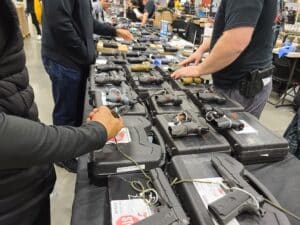As promised, we are looking deeper into the largest-ever survey of gun owners.
We’ve already looked at the National Firearms Survey’s findings on AR-15s and magazines that hold more than ten rounds of ammunition. By providing more evidence of how widespread ownership of both is, the survey seems poised to shake up the legal and political landscape.
Now, we’re looking at the survey’s findings on defensive gun use and gun carry. You’ve seen our reporting on how there have been 1.67 million defensive uses per year, but the survey goes much deeper on the where, when, and how of those incidents.
The same is true for gun carry. The survey shows it has become very common for American gun owners to carry their guns at least on occasion. It breaks down what circumstances they carry under and how often.
Plus, NSSF’s Larry Keane joins the podcast to talk about how the gun industry is resisting plans to track gun sales with credit card merchant codes.
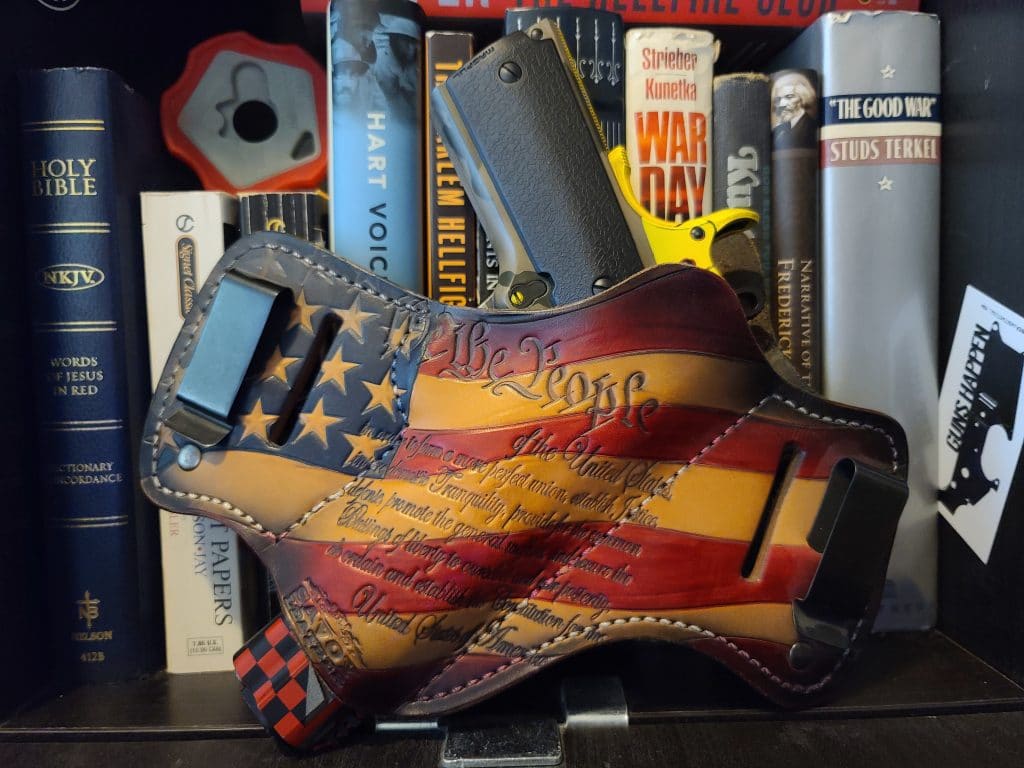
Analysis: Latest Survey Shows the State of American Gun Carry [Member Exclusive]
By Stephen Gutowski
The largest-ever scientific survey of gun owners has documented the overwhelming popularity of gun carry amongst modern gun owners.
Georgetown University Professor William English’s National Firearms Survey offers one of the most comprehensive insights into a multitude of key questions surrounding guns in America. It provides a useful update to the scientific literature on defensive gun uses in America, finding that they occur about 1.6 million times per year.
It also documented the popularity of AR-15s and similar rifles, as well as magazines with a capacity greater than ten rounds. These items are hotly contested in the public debate, and robust data on their ownership could play a key role in ongoing political and legal battles over their future availability.
But at a time when the Supreme Court has just recognized a constitutional right to carry a firearm in public for self-defense, perhaps no aspect of gun ownership is more front and center in the public debate than gun carry. Highly populated states that were affected by the Court’s ruling, such as New York and California, have since scrambled to pass new laws cracking down on the practicality of gun carry. Meanwhile, laws passed earlier this year made it so half the states in the Union now officially allow public carry without the need for a permit.
As the vicissitudes of politics continue to change how governments view gun carry, it’s worth taking a look at how gun owners view carrying. It turns out that carrying a firearm is popular, at least on certain occasions.
A majority of gun owners, 56.2 percent, said there are certain circumstances in which they carry a handgun for self-defense. That works out to around 45.8 million adults saying they carry, a number equal to about the combined population of the states of California and Colorado.
To be clear, the way the survey question was asked allowed for the inclusion of gun owners who say they carry on their own property. Therefore, it’s unlikely that all 45.8 million represent people who carry in public during the course of their daily lives.
Another question in the survey attempted to get closer to that figure and found about 35 percent of gun owners report carrying a handgun with some frequency. That was the combined number of those who said they carry “Sometimes,” “Often,” or “Always or almost always.”
To truly nail down how many gun owners are consistent public gun carriers, English narrowed the estimate using several more factors.
“In order to provide a robust but conservative estimate of those who actually carry in public, we code as ‘public carriers’ those individuals who indicated both that they have a concealed carry permit and that they carry a handgun for self-defense at least ‘sometimes,’” English said. “We also restrict analysis and population estimates to those age 21 and over given that most states restrict those under 21 from carrying concealed in public. Using this simple definition, we find that 26.3% of gun owners are ‘public carriers,’ which translates to approximately 20.7 million individuals who carry handguns in public under a concealed carry regime.”
English’s finding tracks with similar studies conducted by other researchers. The Crime Prevention Research Center, for instance, found that there were 21.52 million carry-permit holders as of 2021.
However, both estimates are likely a sizable undercount.
Half the states in the U.S. now no longer require a permit in order to carry a firearm in public, including 18 at the time English’s survey was conducted. It’s possible that respondents living in permitless carry states answered “no” to the question about having a carry permit, yet carry a firearm with some regularity. Likewise, nearly half of all states allow adults under the age of 21 to carry a handgun in at least some circumstances.
Therefore, the true number of gun owners who carry in public with some regularity is likely many millions higher than the number English arrived at.
Additionally, more than one-third of all gun owning respondents said they have wanted to carry a handgun for self-defense in a particular situation, but local rules prohibited them from doing so.
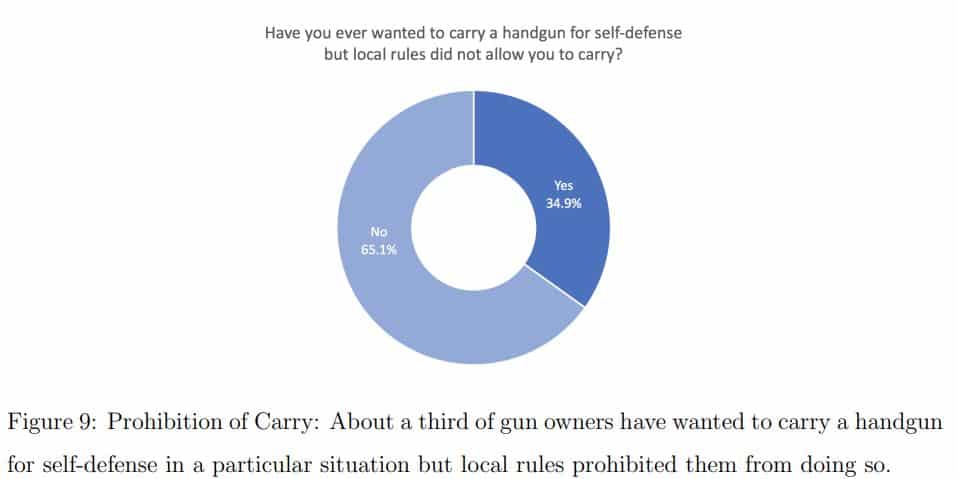
The survey does not expand on this question with any more granularity, but at the very least it suggests a strong demand exists for the ability to carry a handgun for self-defense in more places. Given that the survey was conducted before the Supreme Court’s Bruen decision, it’s quite possible that it captured the segment of the gun-owning population living in states that had restrictive “may-issue” permit policies.
Now that may-issue regimes have been struck down, it’s possible that number has shrunk and the overall number of identifiable “public carriers” has risen considerably. After all, roughly one-quarter of the U.S. population resides in formerly may-issue states.
No matter which way you slice the data, one thing is clear: Gun carry is an enormously popular practice. It’s one that tens of millions of gun owners across the country say they participate in with some regularity, and it’s quite likely to continue growing as more Americans are able to do it legally.
Podcast: NSSF’s Larry Keane on the Industry Reaction to New Credit Card Codes for Gun Stores [Member Early Access]
By Stephen Gutowski
The gun industry is facing a new fight over financing for firearms.
Gun companies have long struggled to obtain and keep banking services in place despite government pressure in the form of Operation Chokepoint and private pressure from big banks refusing to work with them. But now, gun buyers are facing pressure too. Gun-control advocates convinced the organization that oversees credit card merchant codes to create one for gun stores in hopes of flagging “suspicious” transactions for law enforcement.
So, we have Larry Keane on to tell us how the industry is handling the change. He is the Senior Vice President of the National Shooting Sports Foundation (NSSF), which represents gun makers and dealers. They are the literal gun lobby.
Keane said the change is part of a larger plan to try and surveil gun owners. He said the goal is to restrict the ability of Americans to buy guns.
He said the code change alone is unlikely to significantly change how things work because the credit card companies are resisting flagging sales based on it. However, he said the goal is to not only track sales by merchant code but to reform the system to allow credit card companies to see every individual product somebody buys. That would effectively allow them to track, report, and block any gun sale to anyone in the country.
Advocates for the code change argue it could be used to identify patterns that indicate they may be planning a mass shooting. Keane said that’s not realistic. He argued nobody has identified any discernable buying actions that reliably set them apart from the millions of Americans who buy guns every year.
He also talked about the industry slowdown that’s started to show up in major companies’ earnings reports. The two publicly-traded gun makers, Smith & Wesson and Ruger, saw huge dropoffs in revenue and profit. Keane said the downturn was to be expected after two years of record sales, and he isn’t terribly concerned about it.
Plus, Contributing Writer Jake Fogleman explains Dick Heller’s latest win over DC’s gun restrictions.
You can listen to the show on your favorite podcasting app or by clicking here. It is also available on our YouTube channel. As always, the show goes public on Monday, and Reload Members get access the day before.
Come on the Podcast
One of the many perks of a Reload membership is the opportunity to appear on the podcast for a special segment. If you’re interested in joining me, simply reply to this email. Join us!
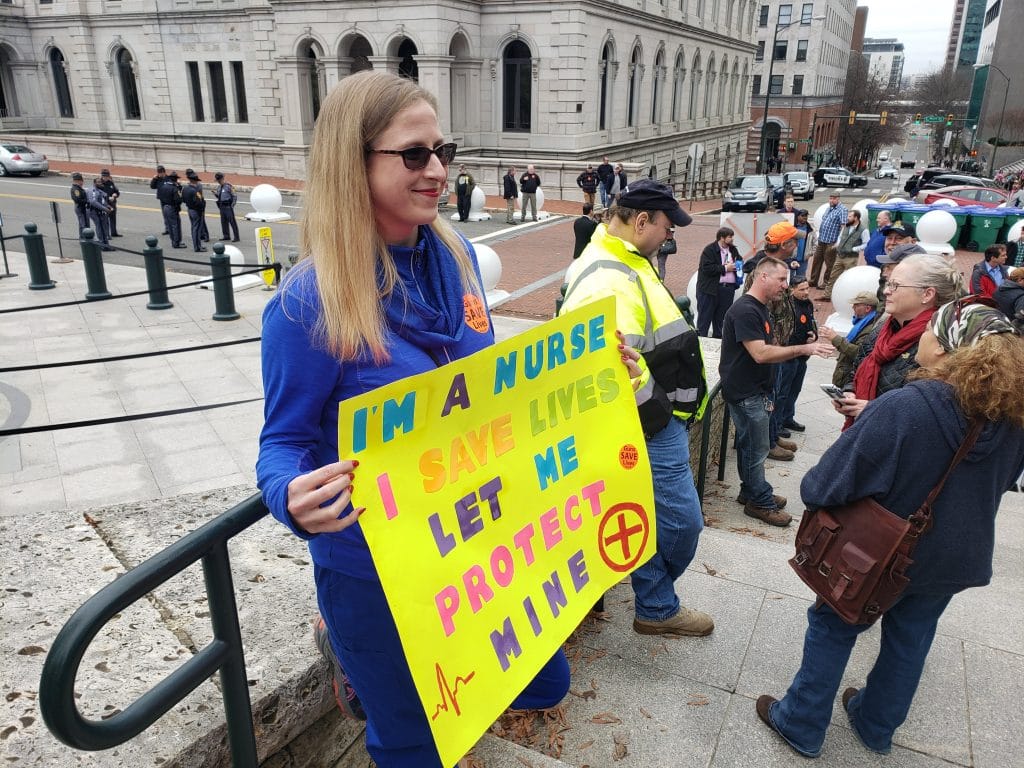
Analysis: How 50 Million Defensive Gun Uses Played Out According to a Massive Survey [Member Exclusive]
By Stephen Gutowski
The largest-ever scientific survey of gun owners found Americans used a gun in self-defense at least 1.67 million times per year. But the poll did a lot more than just count defensive uses; it also detailed how, when, and where they happened.
The National Firearms Survey, conducted by Georgetown University Professor William English, presented a ton of information on key questions surrounding guns in America. It found gun ownership is diversifying and gun carry is broadly popular. It found about a third of gun owners have owned an AR-15 or similar rifle and 50 percent have owned magazines holding more than ten rounds–key information for the legal battles over whether they can be banned.
And, of course, it also found a large number of American gun owners report using their guns to protect themselves. 31.1 percent of gun owners said they’d used a gun in self-defense. That equates to about 25.3 million Americans, according to English.
While a plurality of respondents said they’d only been involved in a single defensive gun use, the majority said they’d used a gun for self-defense more than once. That’s how English determined there were about 50 million reported defensive uses. He found the yearly rate of 1.67 million by dividing that total by the number of adult years the respondents had lived.
English said he did it that way to address one of the critiques of previous survey-based estimates of defense gun uses, which relied on people recounting not only that they used a gun in self-defense but that it happened in the last year.
However, that doesn’t mean it perfectly captures defensive gun uses. Critics have long questioned the validity of survey-based estimates altogether. Often they argue people who self-report using a gun to defend themselves are often misrepresenting what happened and may have even broken the law during the incident. Another common critique is the number of defensive gun uses doesn’t square with the number of justifiable homicides or criminals treated for gunshots.
Similarly, surveys of self-identified crime victims show a lower rate of self-reported gun defensive uses.
English said his estimates square with reported rates of hospital visits for gunshot wounds if you take the most common form of reported defensive gun use into account: incidents where no shots are fired. The more limited estimates, which put self-defense incidents in the tens of thousands rather than millions, do not account for defensive gun uses where nobody is injured. That’s a subset of events that English’s survey found was massive.
“[I]n the vast majority of defensive gun uses (81.9%), the gun was not fired,” he wrote in the preprint paper on the survey. “Rather, displaying a firearm or threatening to use a firearm (through, for example, a verbal threat) was sufficient. This suggests that firearms have a powerful deterrent effect on crime, which, in most cases, does not depend on a gun actually being fired or an aggressor being injured.”
The survey includes stories from a number of respondents who recount their self-defense encounters, including many who did not fire a shot.
“I was walking a long distance through Philadelphia to get to a restaurant and was approached by 3 men who demanded to know why I thought I could go through their neighborhood,” one respondent wrote. “I told them I did not want any trouble and tried to continue walking, but one stood in my way and asked if I actually thought I was going to leave without answering them. I began to wonder if I was going to be robbed or assaulted when they first approached and at this point, it seemed like they would prevent me from leaving. I lifted my shirt and placed my hand on a pistol I was legally able to conceal carry and said yes I would be leaving. They backed away from me but continued to yell things at me as I left the area. I never pulled the gun out, but them knowing I had it and may use it to stop them was enough to escape unharmed.”
English also argued there were several reasons to believe the survey actually represented a significant undercount of defensive gun uses.
“Note that this estimate is inherently conservative for two reasons,” he wrote. “First, it assumes that gun owners possessed firearms, or had access to firearms, from the age of 18. In so far as firearms were only first acquired/accessed by some respondents in later years, this would reduce the number of adult firearms-owning years represented by the survey responses and result in a higher estimate of the number of defensive incidents per year. Second, this figure only captures defensive gun uses by those currently indicating firearms ownership. According to Kleck and Gertz (1995), only 59.5% of respondents who reported a defensive gun use personally owned a gun.”
He said the number of uses would be closer to 2.5 million per year if you took those factors into account.
The survey also found those self-defense incidents were most likely to occur outside the home. Although, the most common were those that happened on the defender’s property. After that was inside the home, then in a public place.
The defenders were by far most likely to use handguns, according to the survey. That was followed by shotguns and then rifles.
Most defenders reported facing more than one assailant during the incident. Though, 48.8 percent said they faced only a single attacker. Nearly a third said they were up against two attackers. The numbers decrease precipitously from there with 3.2 percent saying they had to deal with 5 or more assailants.
English also examined the demographics of gun defense. He found men were more likely to use a gun in self-defense, with 33.8 percent claiming to have done so, but 27.3 percent of female gun owners also reported using a gun to defend themselves. The survey found minority groups that tend to be victims of crime at higher rates, such as Black Americans, also tended to report using a gun in self-defense at higher rates.
The survey also asked respondents if they’d ever been in a self-defense scenario where they felt they may have benefited from having a magazine capable of holding more than ten rounds. English said 550 people said yes and offered up descriptions of those incidents.
“I went in but into a store and 4 thugs approached me telling me to give them money,” one respondent said. “I produced my handgun at my side, and they left. If this had been a shooting with multiple bad guys with guns a 15-round magazine is best.”
“Having less than 10 rounds against 3 attackers, especially if they were also armed, would have put me at a disadvantage if I was unable to accurately hit my targets initially and they continued to pursue me,” the respondent who used his gun to escape a fight in Philadelphia said.
But English found that even including incidents where somebody brandished a gun in self-defense constitutes an undercount of how often Americans use firearms to prevent attacks. His survey also asked respondents if they believed they had ever deterred a potential attacker using the mere knowledge they were armed rather than an explicit threat of using a gun in self-defense. He found incidents like that were nearly as common as explicit defensive gun uses.
“Separate from the self-defense incidents summarized earlier, 31.8% of gun owners reported that the mere presence of a gun has deterred criminal conduct, and 40.2% of these individuals indicated that this has happened on more than one occasion,” English wrote. “Extrapolated to the population at large, this suggests that approximately 25.9 million gun owners have been involved in an incident in which the presence of a firearm deterred crime on some 44.9 million occasions. This translates to a rate of approximately 1.5 million incidents per year for which the presence of a firearm deterred crime.”
The survey is unlikely to end the debate over just how common defensive gun uses are in the United States. But, given how important the answer to that question is to the debate over whether the potential benefits of gun ownership outweigh the potential downsides, a comprehensive survey of over 16,000 gun owners from across all 50 states is a valuable contribution to that debate. The expansive new data on how Americans say they use guns to defend themselves will likely be poured over for years to come.
That’s it for now.
I’ll talk to you all again soon.
Thanks,
Stephen Gutowski
Founder
The Reload


